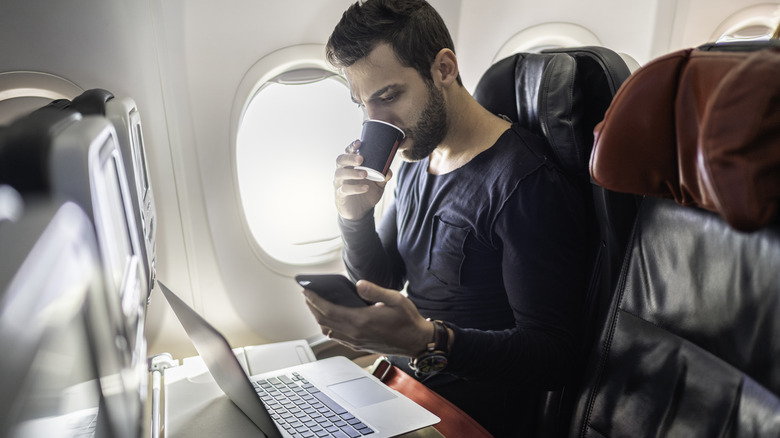What To Know About In-Flight Wi-Fi Before Your Trip
As if it weren't enough to travel halfway around the world in less than a day, now we can stream movies, answer emails, and surf the internet — all at 30,000 feet. If you've ever used in-flight Wi-Fi, you'll know there is certainly room for improvement but with each passing year, it's getting better and better.
There's a good reason in-flight Wi-Fi isn't perfect. There are two ways an airplane can access the internet and deliver Wi-Fi to its passengers: air-to-ground and satellite. Air-to-ground Wi-Fi connects to cell towers on the ground while satellite Wi-Fi connects to satellites in orbit. Some airlines — like Hawaiian Airlines — are even working on adding SpaceX's Starlink Wi-Fi to their airplanes.
When it comes to which one is better, you'll probably notice planes that use satellite Wi-Fi are a bit more consistent whereas air-to-ground Wi-Fi can drop out when out of range of cell towers. This can be over the ocean or large areas of rural or uninhabited land which you can imagine is a common occurrence when flying over the middle of the U.S. or the Atlantic Ocean or Pacific Ocean. Here's the scoop on how to access in-flight Wi-Fi during your next journey in the skies.
Ways to access in-flight Wi-Fi
Regardless of the quality of in-flight Wi-Fi, airlines can and often do charge passengers to access it. Though some airlines do offer free unlimited browsing, it'll probably be a while before it becomes a complimentary service across the industry. With that said, many airlines these days offer complimentary Wi-Fi connection for messaging and in-flight entertainment on your personal devices. However, if you want to do more than message your friends, you can purchase a Wi-Fi pass. These passes range from 1 to 24 hours; for the flight duration; and by data usage (usually in megabytes). There are even monthly passes or subscriptions for frequent flyers.
Prices for passes can vary widely, though, and depend on your airline, flight duration, and region. However, you can currently count on 1-hour passes costing between $5 to $12 with day passes ranging more widely from $8 to $30. If you plan ahead though, you can sometimes get passes for a discount if you purchase them in advance of your flight. In some cases you can even get full access to in-flight Wi-Fi completely free with a business class ticket.
Airlines with great in-flight Wi-Fi offers
JetBlue offers free Wi-Fi, so you won't have to worry about missing another important email or keeping up with the latest news as their entire fleet comes with the convenient service. Meanwhile, those who are SkyMiles members with Delta Airlines will be happy to hear they also have a robust in-flight Wi-Fi offering. On domestic flights, SkyMiles members can browse the internet completely free. Luckily, enrollment in SkyMiles is easy and there are no special requirements. While this deal is currently only available for domestic flights, it's coming to international flights by the end of 2024.
British Airways also offers in-flight high-speed Wi-Fi as well, so you'll be ready to stay connected on your next flight across the pond. Their browsing and streaming packages for long-haul flights range from £4.99 to £21.99, which is not bad in comparison to other airlines' long-haul offerings.


